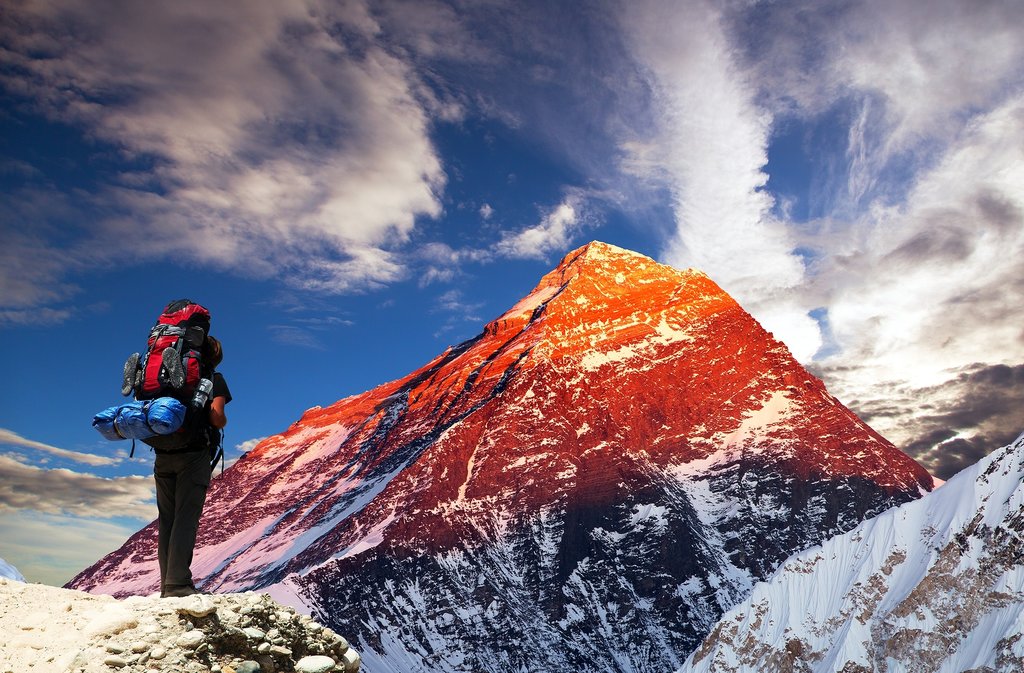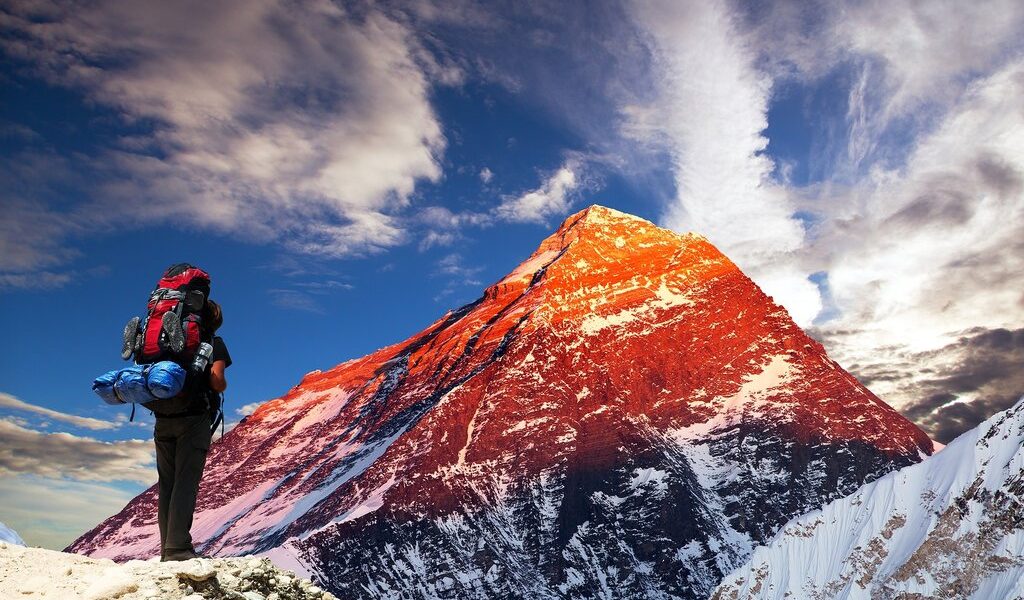
Along with March, April is a popular month for trekking in Nepal. Temperatures are generally warm (or at least, not too cold in the high Himalaya) and the monsoon rains are still several weeks away. Here are some important things to know about traveling to Everest Base Camp in April.
## Trekking to Everest Base Camp and Beyond in April: A Comprehensive Guide
April presents a unique window of opportunity for trekking in the magnificent Everest region. While Kathmandu, the bustling capital city, may be experiencing a noticeable rise in temperatures, the mountain regions retain a more temperate climate, ideal for undertaking challenging yet rewarding treks. Before embarking on your adventure, it’s essential to understand the specific weather conditions, popular routes, and logistical considerations that come into play during this peak trekking season.
The average April temperatures in Namche Bazaar, a crucial acclimatization stop on the iconic Everest Base Camp (EBC) trek, typically range from a brisk 34°F (1°C) to a comfortable 53°F (12°C). Considering Namche Bazaar’s significant altitude of 11,290 feet (3440 meters), these temperatures offer a welcome respite from the warmer conditions below. However, it’s crucial to remember that as you ascend to higher elevations along the trail, temperatures will inevitably decrease, necessitating appropriate layering and cold-weather gear. The temperature at Everest Base Camp itself will be significantly colder than in Namche Bazaar.
The advantage of trekking in April extends beyond the pleasant temperatures. Rainfall is generally scarce during this month, minimizing the risk of slippery trails and potential disruptions to your itinerary. Although, as April progresses, a slight increase in humidity may occur, potentially causing a mild haze that could, on occasion, slightly obscure the panoramic mountain vistas. While the visibility in March and April might not quite match the exceptional clarity experienced during the winter months, the favorable balance between warmth and visibility makes April a highly sought-after time to trek.
However, the prime trekking conditions of April draw a significant number of adventurers to the Everest region. The EBC trail, in particular, experiences a surge in popularity during this period, creating a bustling atmosphere along the route. Securing accommodation in the teahouses, the traditional lodges that provide food and lodging to trekkers, can become challenging. It is advisable to enlist the services of a reputable guide who possesses the local knowledge and connections to secure comfortable and reliable lodging.
For those seeking a more solitary trekking experience, several alternative routes within the Everest region offer a welcome escape from the crowds. These routes provide equally stunning scenery while allowing you to immerse yourself in the tranquility of the Himalayas. Consider opting for an off-shoot of the classic EBC trek, allowing you to still witness Everest but along less crowded paths, or consider a completely alternative route.
If your heart is set on conquering the classic EBC trek, April remains a highly viable choice, provided you are prepared for the presence of other trekkers. However, if you prioritize solitude and wish to savor unobstructed views, exploring alternative routes that overlap with the EBC trail is highly recommended. These trails provide glimpses of the majestic Everest while offering a more intimate encounter with the Himalayas.
The breathtaking Gokyo Lakes trek, for example, presents a captivating alternative. This route diverges from the main EBC trail, leading you towards a series of spectacularly turquoise glacial lakes. The Gokyo Lakes trek also provides awe-inspiring perspectives of Everest and its neighboring peaks. For seasoned trekkers seeking a more demanding adventure, the renowned Three Passes trek offers an exhilarating traverse across three challenging high-altitude passes in the region. This trek demands a high level of fitness and acclimatization but rewards you with unparalleled views and a profound sense of accomplishment.
For those interested in cultural immersion alongside stunning landscapes, the Tengboche Monastery trek provides a captivating experience. This route leads you to Tengboche Monastery, one of the most significant Tibetan Buddhist monasteries in Nepal, where you can witness vibrant religious practices and experience the spiritual heart of the Sherpa community. The Dingboche trek shares similarities with the Tengboche route but extends further to the charming settlement of Dingboche, offering additional opportunities for acclimatization and exploration.
The Ama Dablam Base Camp trek is another excellent choice, allowing you to witness the awe-inspiring beauty of Ama Dablam, a mountain often admired from afar during other treks in the region. This trek provides a unique perspective and a closer encounter with one of the Himalayas’ most iconic peaks.
For a truly immersive and extended adventure, consider the Arun Valley to Everest Base Camp Trek. This longer, more remote route to Everest takes you through the lush Arun Valley, nestled between the Sagarmatha and Makalu-Barun National Parks. The trek begins in Tumlingtar, located east of Everest, and eventually merges with the main EBC trail near the iconic viewpoint of Kala Pattar.
April also presents an ideal opportunity to tackle a trekking peak, offering a more challenging and rewarding experience for those with mountaineering aspirations. Island Peak, standing at 20,305 feet (6,189 meters), is a popular choice, providing a challenging yet accessible introduction to Himalayan climbing. The trek to Island Peak largely follows the traditional EBC trail, allowing you to experience the highlights of the Everest region while venturing off the beaten path.
Another tempting option is Mera Peak, Nepal’s highest trekking peak, soaring to a majestic 21,246 feet (6,476 meters). The trek to Mera Peak is particularly memorable, requiring passage through the remote Hinku and Hongu Valleys, which diverge from the main EBC trail before reaching Namche Bazaar.
Preparing adequately for your trek is essential, irrespective of the chosen route. Packing appropriately for the diverse conditions of April is crucial. A high-quality three-season sleeping bag, a warm down jacket, moisture-wicking merino base layers, and a reliable rain jacket are essential items. Remember to prioritize layering to adapt to changing temperatures throughout the day.
The most convenient way to access the Everest region is by flying from Kathmandu to Lukla. However, these flights are susceptible to delays or cancellations due to weather conditions in Kathmandu, Lukla, or along the flight path. Despite the low rainfall in April, Kathmandu can experience increased levels of smog and dust, potentially impacting flight schedules. Given the high demand during April, booking your flights well in advance is highly recommended.
For a more adventurous approach, consider trekking to Lukla from Jiri. This route, known as the ‘Pioneers’ Route,’ retraces the original trekking path used by early Western mountaineers before the construction of the airport in Lukla. Alternatively, you can fly from Kathmandu to Phaplu and trek to Lukla through the scenic Solukhumbu region. This less-traveled route offers a more gradual ascent and a deeper immersion into the local culture. These treks add several days to standard itineraries in the Everest region.
The Sherpa people, the primary inhabitants of the Everest region, predominantly practice Tibetan Buddhism. While major Hindu festivals are less prevalent in the mountains, you may encounter Nepali New Year celebrations if passing through Kathmandu during your travels. The Nepali New Year typically falls in mid-to-late April, following a lunar calendar.
In conclusion, April offers a superb blend of favorable weather conditions and breathtaking scenery for trekking in the Everest region. Whether you choose the iconic EBC trek or opt for a quieter alternative, careful planning and preparation will ensure an unforgettable Himalayan adventure. Remember to embrace the challenge, respect the local culture, and savor the unparalleled beauty of the world’s highest peaks.
B-1712

